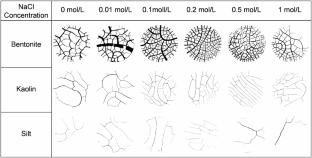Desiccation cracks in soil cause undesirable impacts on soil properties. Increasing extreme heat and drought events may lead to more severe soil salinization and desiccation cracking. However, the discrepancies and intrinsic mechanisms of the cracking behaviors of different fine-grained soils affected by pore-fluid salinity are unclear. This study investigates the pore-fluid salinity effect on cracking characteristics of different fine-grained soils. Desiccation crack tests with a wide range of salt concentrations are conducted for three fine-grained soils with different sensitivity to pore-fluid chemistry. Liquid limit tests and scanning electron microscopy analyses are carried out to investigate the effect of particle-fluid interactions and microstructure changes on cracking. The degree of cracking is the largest in bentonite and varies greatly with the change of pore-fluid salinity. Cracking in kaolin is less affected by pore fluids, showing a slight decrease at large NaCl concentrations. The degree of cracking is the lowest in silt and shows no clear trend with the change of pore-fluid salinity. Detailed quantitative characteristics of crack patterns are compared. Liquid limit tests and scanning electron microscopy analyses reveal different electrical sensitivity of the three soils to pore fluid influenced by particle-fluid interactions and changes in microstructure. Crack parameters exhibit a larger variation for bentonite with high electrical sensitivity and are relatively stable for soils with low electrical sensitivity. The correlation between the electrical sensitivity and the crack parameters is relevant to the evaluation and control of desiccation crack in fine-grained soils with various pore-fluid salinities.


